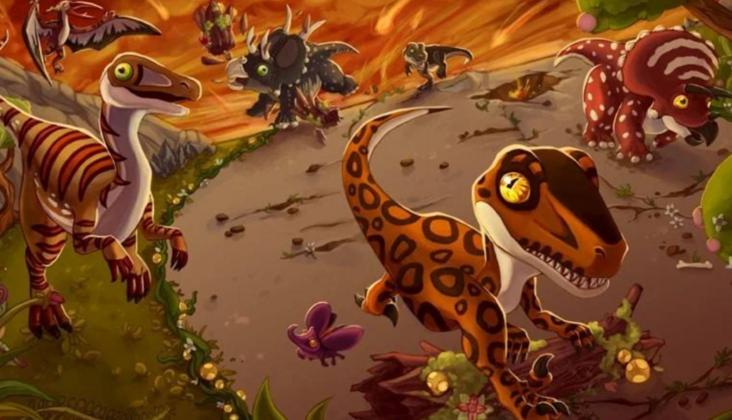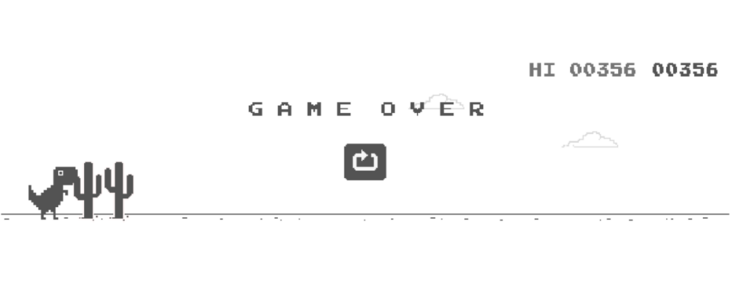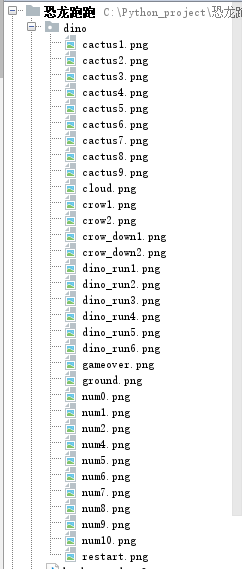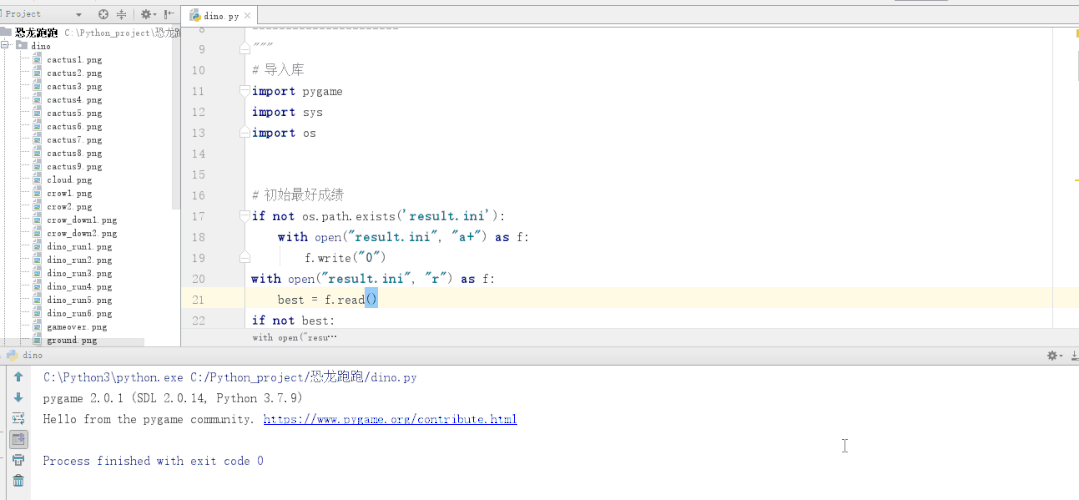
I believe many people have played the dinosaur run game provided by Chrome browser. When we disconnect the Internet or directly enter the address in the browser“ chrome://dino/ ”Can enter the game

Today we use Python to make a similar game
Material preparation
First, we prepare the materials needed for the game, such as dinosaur pictures, cactus pictures, sky, ground, etc. we put them in the dino folder

Game logic
We use Pygame to make games. First initialize the game page
import pygame
# initialization
pygame.init()
pygame.mixer.init()
# Set window size
screen = pygame.display.set_mode((900, 200))
# Set title
pygame.display.set_caption("Dinosaur jump")
# Use the system's own font
my_font = pygame.font.SysFont("arial", 20)
score = 0
# Background color
bg_color = (218,220,225)Next, we load various materials into memory
# Load normal dinosaur
dino_list = []
temp = ""
for i in range(1, 7):
temp = pygame.image.load(f"dino/dino_run{i}.png")
dino_list.append(temp)
dino_rect = temp.get_rect()
index = 0
# Initial value of x
dino_rect.x = 100
# Initial value of y
dino_rect.y = 150
# print(dino_rect)
# Set the initial velocity on the y-axis to 0
y_speed = 0
# Initial take-off speed
jumpSpeed = -20
# Simulated gravity
gravity = 2
Loading ground
ground = pygame.image.load("dino/ground.png")
# Load cactus
cactus = pygame.image.load("dino/cactus1.png")
cactus_rect = cactus.get_rect()
cactus_rect.x,cactus_rect.y = 900,140
# Load again
restart = pygame.image.load("dino/restart.png")
restart_rect = restart.get_rect()
restart_rect.x,restart_rect.y = (900-restart.get_rect().width)/2,(200-restart.get_rect().height)/2+50
# Load gameover
gameover = pygame.image.load("dino/gameover.png")
gameover_rect = gameover.get_rect()
gameover_rect.x, gameover_rect.y = (
900-gameover.get_rect().width)/2, (200-gameover.get_rect().height)/2
# Ground movement speed and distance
ground_speed = 10
ground_move_distance = 0
# Clock
clock = pygame.time.Clock()
# Do it again
is_restart = False
text_color = (0,0,0)Next, we maintain the game process through a while loop
while True:
# 30 times per second
clock.tick(30)
...In the above loop, we need two detection mechanisms, event detection and collision detection
event detection
# event detection
for event in pygame.event.get():
if event.type == pygame.QUIT:
if result_flag:
with open("result.ini", "w+") as f:
f.write(str(best))
sys.exit()
# Spacebar detection
if event.type == pygame.KEYDOWN:
if event.key == pygame.K_SPACE and dino_rect.y==150:
y_speed = jumpSpeedIt mainly detects exit events and spacebar events
collision detection
# collision detection
if dino_rect.colliderect(cactus_rect):
while not is_restart:
# event detection
for event in pygame.event.get():
if event.type == pygame.QUIT:
if result_flag:
with open("result.ini", "w+") as f:
f.write(str(best))
sys.exit()
# Spacebar detection
if event.type == pygame.KEYDOWN:
if event.key == pygame.K_SPACE:
is_restart = True
bg_color = (218,220,225)
ground_speed = 10
# Set the picture again
screen.blit(restart, restart_rect)
screen.blit(gameover, gameover_rect)
pygame.display.update()For the collision, as long as the dinosaur collides with the cactus, the game ends and the picture is displayed again
Because we want the game to record our best results, we use the local file to store the game records. When the game is over, we judge whether to write the new results into the file according to the current game results
Here is the code to calculate the running distance and the best result
# Statistical distance
score += ground_speed
score_surface = my_font.render("Distance: "+str(score), True, text_color)
# Calculate the best score
result_flag = False
if score >= best:
best = score
result_flag = True
best_result = my_font.render("Best Result: " + str(best), True, text_color)We also need to add different game difficulties to different distances. After all, the farther we run, the more difficult it is
# Change the background color, and the score is greater than 4000
if score > 4000:
bg_color = (55,55,55)
ground_speed = 15
text_color = (255,255, 255)
# Change the background color, and the score is greater than 8000
if score > 8000:
bg_color = (220,20,60)
ground_speed = 20
text_color = (255, 255, 255)
# Change the background color, and the score is greater than 12000
if score > 12000:
bg_color = (25,25,112)
ground_speed = 25
text_color = (255, 255, 255)
# Set background color
screen.fill(bg_color)Finally, we render all the elements loaded into memory on the screen
# Set ground picture 1
screen.blit(ground, (0-ground_move_distance, 180))
# Set ground picture 2, outside the right boundary
screen.blit(ground, (900-ground_move_distance, 180))
# Set dinosaur pictures
screen.blit(dino_list[index % 6], dino_rect)
# Set cactus picture
screen.blit(cactus, cactus_rect)
# Set score
screen.blit(score_surface,(780,20))
# Set best score
screen.blit(best_result, (20, 20))
pygame.display.update()In order to increase the game, we add background music and jumping sound
pygame.mixer.music.load("background.mp3")
pygame.mixer.music.play(-1, 0)
sound = pygame.mixer.Sound('preview.mp3')In this way, a simple and easy-to-use dinosaur running game is completed. Let's see the effect

end of document
Your favorite collection is my greatest encouragement!
Welcome to follow me, share Python dry goods and exchange Python technology.
If you have any opinions on the article or any technical problems, please leave a message in the comment area for discussion!